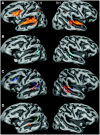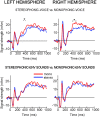Attention Modulates the Auditory Cortical Processing of Spatial and Category Cues in Naturalistic Auditory Scenes
- PMID: 27375416
- PMCID: PMC4894904
- DOI: 10.3389/fnins.2016.00254
Attention Modulates the Auditory Cortical Processing of Spatial and Category Cues in Naturalistic Auditory Scenes
Abstract
This combined fMRI and MEG study investigated brain activations during listening and attending to natural auditory scenes. We first recorded, using in-ear microphones, vocal non-speech sounds, and environmental sounds that were mixed to construct auditory scenes containing two concurrent sound streams. During the brain measurements, subjects attended to one of the streams while spatial acoustic information of the scene was either preserved (stereophonic sounds) or removed (monophonic sounds). Compared to monophonic sounds, stereophonic sounds evoked larger blood-oxygenation-level-dependent (BOLD) fMRI responses in the bilateral posterior superior temporal areas, independent of which stimulus attribute the subject was attending to. This finding is consistent with the functional role of these regions in the (automatic) processing of auditory spatial cues. Additionally, significant differences in the cortical activation patterns depending on the target of attention were observed. Bilateral planum temporale and inferior frontal gyrus were preferentially activated when attending to stereophonic environmental sounds, whereas when subjects attended to stereophonic voice sounds, the BOLD responses were larger at the bilateral middle superior temporal gyrus and sulcus, previously reported to show voice sensitivity. In contrast, the time-resolved MEG responses were stronger for mono- than stereophonic sounds in the bilateral auditory cortices at ~360 ms after the stimulus onset when attending to the voice excerpts within the combined sounds. The observed effects suggest that during the segregation of auditory objects from the auditory background, spatial sound cues together with other relevant temporal and spectral cues are processed in an attention-dependent manner at the cortical locations generally involved in sound recognition. More synchronous neuronal activation during monophonic than stereophonic sound processing, as well as (local) neuronal inhibitory mechanisms in the auditory cortex, may explain the simultaneous increase of BOLD responses and decrease of MEG responses. These findings highlight the complimentary role of electrophysiological and hemodynamic measures in addressing brain processing of complex stimuli.
Keywords: auditory attention; auditory cortex (AC); auditory scene analysis; fMRI BOLD; magnetoencephalography (MEG).
Figures




Similar articles
-
Selective auditory attention within naturalistic scenes modulates reactivity to speech sounds.Eur J Neurosci. 2021 Nov;54(10):7626-7641. doi: 10.1111/ejn.15504. Epub 2021 Nov 3. Eur J Neurosci. 2021. PMID: 34697833 Free PMC article.
-
Stimulus-dependent activations and attention-related modulations in the auditory cortex: a meta-analysis of fMRI studies.Hear Res. 2014 Jan;307:29-41. doi: 10.1016/j.heares.2013.08.001. Epub 2013 Aug 11. Hear Res. 2014. PMID: 23938208 Review.
-
Activity in Human Auditory Cortex Represents Spatial Separation Between Concurrent Sounds.J Neurosci. 2018 May 23;38(21):4977-4984. doi: 10.1523/JNEUROSCI.3323-17.2018. Epub 2018 Apr 30. J Neurosci. 2018. PMID: 29712782 Free PMC article.
-
Auditory cortical responses evoked by pure tones in healthy and sensorineural hearing loss subjects: functional MRI and magnetoencephalography.Chin Med J (Engl). 2006 Sep 20;119(18):1548-54. Chin Med J (Engl). 2006. PMID: 16996009
-
How do auditory cortex neurons represent communication sounds?Hear Res. 2013 Nov;305:102-12. doi: 10.1016/j.heares.2013.03.011. Epub 2013 Apr 17. Hear Res. 2013. PMID: 23603138 Review.
Cited by
-
Selective auditory attention within naturalistic scenes modulates reactivity to speech sounds.Eur J Neurosci. 2021 Nov;54(10):7626-7641. doi: 10.1111/ejn.15504. Epub 2021 Nov 3. Eur J Neurosci. 2021. PMID: 34697833 Free PMC article.
-
Evidence for cue-independent spatial representation in the human auditory cortex during active listening.Proc Natl Acad Sci U S A. 2017 Sep 5;114(36):E7602-E7611. doi: 10.1073/pnas.1707522114. Epub 2017 Aug 21. Proc Natl Acad Sci U S A. 2017. PMID: 28827357 Free PMC article.
References
LinkOut - more resources
Full Text Sources
Other Literature Sources

